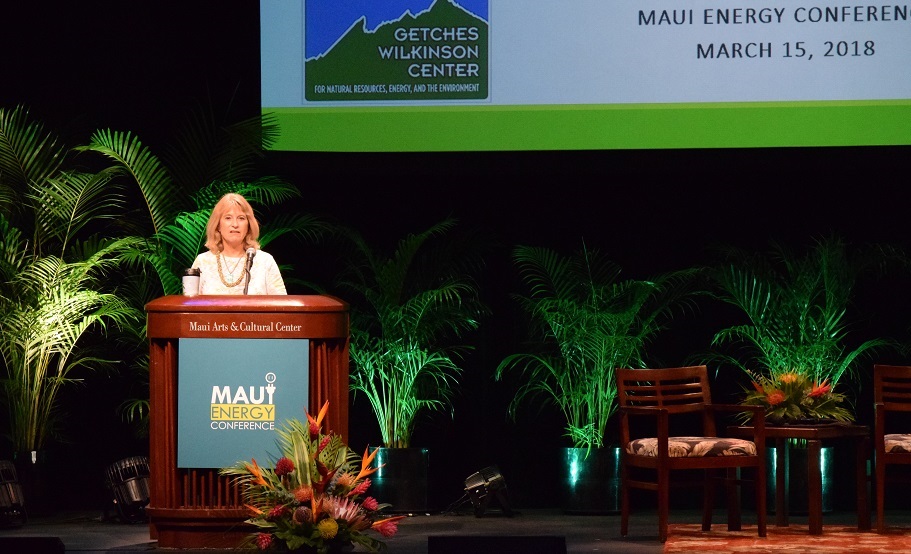
by HEC Team | Mar 27, 2018 | 2018, News
The Maui Energy Conference returned to the Maui Arts & Cultural Center March 14-15, 2018 to celebrate its 5th Anniversary and the 10th Anniversary of the Hawaii Clean Energy Initiative (HCEI). The conference began by discussing HCEI’s landmark effort and accomplishments, while the rest of the conference explored the challenges that remain. The event, presented by the Maui Economic Development Board and supported by the Mayor’s Office of Economic Development, explored the theme Decarbonization: A Business Opportunity for Innovative Communities.
The conference, featuring keynote speakers, panel sessions, case studies, exhibits and networking, attracted 320 energy-industry leaders from Hawaii, the Mainland U.S., Japan, and Europe. Energy experts and stakeholders tackled critical cross-sector issues and examined groundbreaking strategies and new pathways in renewable energy and carbon reduction. Keeping in mind the 10-year anniversary of HCEI, speakers discussed the limits of the Initiative, and whether it addressed carbon, as Hawaii moves toward its 100 percent renewable goal.
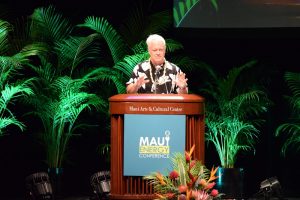
Doug McLeod, Chair of the Conference Program Committee sets the tone with an introduction on the Business of Carbon.
“We owe a debt of gratitude to HCEI,” said Doug McLeod, conference program committee chair. “They raised the profile of Hawaii on the national energy scene in a way that created the demand for a conference like this. When we looked at the program for this year, we kept asking ourselves what the logical next step is for Hawaii after 10 years of HCEI.”
McLeod explained how, in the last 12 months, the energy scene in Hawaii has shown us the answers. “From the dispute over the Hu Honua biomass plant on the Big Island to the Sierra Club complaint about the use of coal by HC&S on Maui, to the efforts by the mayors of all the counties in Hawaii to move toward electrification of transportation, and even the ongoing discussion of whether waste-to-energy projects such as H Power on Oahu, are really a net benefit to the environment, we are seeing common themes,” McLeod said.
“Are we really making power in a way that matches our goals and our values?”
The conference participants explored the theme at a policy and regulatory level as well as at the business level. A panel discussion on Convergence examined “how it all comes together” for a shared solution that benefits all stakeholders. Other topics included Decarbonizing Transportation; Regulating Carbon: The Best Solutions; Storage Technologies, and more.
Hawaii became the first U.S. state to set a date, 2045, for the total decarbonization of its power supply. With renewable energy booming since 2008, when the state set a goal of making renewables 40 percent of its power mix by 2030, government and utility incentives fostered wind power and solar. Currently, smarter grid design and operation is a rich area of study that has already started to smooth the integration of variable and distributed renewable energy sources. Environmental factors, the abundance of renewable energy resources such as wind, solar, geothermal, hydroelectric and ocean power, are all reasons to move more quickly.
STATE REPRESENTATIVE CHRIS LEE
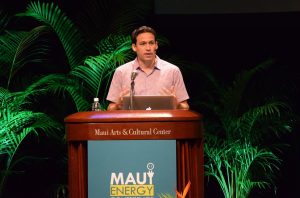
Rep. Chris Lee, chair of the state House Committee on Energy and Environmental Protection, explained in his keynote address that island communities are especially vulnerable to natural and man-made disaster with the potential to disrupt access to electricity and damage critical energy infrastructure. Referring to the aftermath of Hurricane Maria, Lee used Puerto Rico as an example of what Hawaii needs to think about in terms of its own vulnerability.
“Looking at the data is not only prudent but necessary,” Lee said. Viewing Honolulu’s rising sea levels as an effect of inaction, the costs of not going completely green are so high that the costs to ratepayers are comparatively inconsequential.”
Lee continued, “We need to rethink our approach to reach our goal. All stakeholders have a piece of the puzzle and need to align to work more efficiently. We need to discuss what the private sector wants; technology is demanding it.”
Using the electric bus as an example, Lee talked about the electrification of transportation in Hawaii. “Electrification will eventually be cheaper than cars running on gas,” he said. ‘Once that happens, the growth in EVs will be exponential and Hawaii needs to be prepared by setting up more charging facilities for cars. New charging infrastructure and other renewables will also help create jobs and new opportunities.”
As information about the grid is digitized, computers and cloud-based analytics have the potential to produce 20 percent cost savings by running and planning the grid more efficiently. Lee described legislative bills to lay out the framework for a clean transportation system, with benchmarks to reduce carbon as the market moves forward.
“It’s on government and regulatory agencies to make sure investments benefit everyone,” he said. “It is on the Public Utilities Commission (PUC) to make sure there are incentives for all people.”
THE LIMITS OF THE HAWAII CLEAN ENERGY INITIATIVE
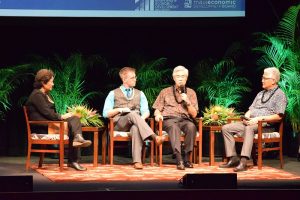
l to r: Hermina Morita, Energy Dynamics; William Giese, Executive Director, Hawaii Solar Energy Association; Alan Oshima, President and Chief Executive Officer, Hawaiian Electric Company; and Gerald Sumida, Partner, Carlsmith Ball LLP.
Presenters attributed progress achieved over the last decade to the private sector, demonstrating not only private entities’ commitment to renewable and clean energy alternatives, but also recognition that such technologies are essential to Hawaii’s future self-sufficiency and resilience.
This panel was moderated by William Giese, Executive Director, Hawaii Solar Energy Association, with panelists Hermina Morita, Energy Dynamics; Alan Oshima, President and Chief Executive Officer, Hawaiian Electric Company; and Gerald Sumida, Partner, Carlsmith Ball LLP.
“There are no easy solutions,” said Morita. “HCEI lost crucial political alignment. The most urgent issue in the energy system is now in transportation and infrastructure, causing Hawaii’s future to be costlier than it should be.”
Sumida added, “HCEI came up with scenarios for 70 percent clean energy by 2030—a basis for a roadmap going forward, guidelines for short, medium and long-term goals. The vision for Hawaii needs to be updated. We could stand as a model for the world.”
Oshima concluded, “We must transition our commitment. The overall global perspective is how does the economy support where we want to be? State policy is important. All stakeholders need to collaborate on what we really want to accomplish for our state. It’s not just about energy. We must provide all things for customer value.”
BUSINESS OPPORTUNITIES CREATED BY HCEI
Ulupono Initiative General Partner Kyle Datta shared his insights on business opportunities created by HCEI, in a panel moderated by Luis Salaveria, Director, Department of Business, Economic Development and Tourism, State of Hawaii. Datta was joined by Dawn Lippert, CEO of Elemental Excelerator, and Wren Wescoatt, Principal of 7 Generation Consulting.
With HCEI marking its 10th year in 2018, the group gave its perspective on what the agreement accomplished and the stage it has set for the future.
“HCEI changed the game over what was possible and what was desirable,” Datta said. “Consensus attracted interest and put the state on the map. It helped to galvanize large landowners to commit resources, getting not only the energy sector but the land sector to say we are going on with this work.”
Wescoatt added, “Progress is largely because of private interest, but HCEI set a direction providing an overarching policy that aligned government agencies. The state does not necessarily need to drive but can be helpful by setting the conditions for progress.”
Datta agreed, “Investors only invest if it’s a fair playing field. The investors and utilities need consistency of policy. One of the great things HCEI did was to really make the PUC independent.”
Lippert said, “The availability of local expertise and a qualified, skilled workforce is also vital. “From an innovator perspective, it’s a competitive market for innovation. The more aligned we are and the better leadership we have locally, the greater chance we have to attract talent.”
According to Lippert the plan must include how the state manages its data. Accurate empirical data is essential to providing decision-makers, both public and private, the information they need to act.
Lippert said, “The whole issue of how we share data in this state is a huge question. The business community is passionate about fixing the world for future generations. Entrepreneurs and clean energy actors are setting the stage for significant opportunities and new career paths for our youth. These jobs will not only help invent the future but will also lead to a cleaner and more resilient island.”
Elemental Excelarator Funds Kevala
CEO Dawn Lippert, while overseeing the strategic direction of Elemental Excelerator and the execution of its mission, has been investing in startups since 2009. One of the company’s current startups, Kevala Analytics, was founded by Aram Shumavon. Based in San Francisco but working in Honolulu, the company maps out the island’s distribution network, rooftop photovoltaic systems, and bulk power resources.
“Kevala is undertaking a stakeholder-driven map exercise,” explained Shumavon. “In the coming months, as the mapping exercise wraps up, Kevala, along with its partners Grid Works and the Hawaii Natural Energy Institute, are building the data sets to drive trillions of dollars in value into the public domain.”
“My project, Pathways to an Open Grid, is focused on digital data that make the grid more efficient,” said Shumavon. “America’s electric grid, the power plants and wires that produce and distribute electricity, cost roughly 5 trillion to build. But the decision to invest that money was made when the grid was planned around century-old technologies and there was little understanding of how technologies like wind and solar would change the value of the grid itself.”
CONVERGENCE: HOW IT ALL COMES TOGETHER
The panel on Convergence: How it all Comes Together, was moderated by Scott Seu, Senior Vice President of Public Affairs, Hawaiian Electric Company. Panelists included Stacey Crowley, Vice President, Regional and Federal Affairs, California Independent System Operator Corporation; Martha Symko-Davies, Laboratory Program Manager, Energy Systems Integration, National Renewable Energy Laboratory; and Mike Yamane, Chief of Operations, Kauai Island Utility Cooperative.
“Convergence is how we got here,” said Yamane. “Planning different community involvement was key to our success. We had to decide what technology to use to enhance the grid. Developers, state agencies, landowners and community working together all added to Kauai’s success story.”
Crowley said, “Outreach and education to energy leadership and organizations serve as a key liaison to those interested in learning about the benefits of the Independent System Operator market. Strength is developing strategic partnerships and fostering consensus. This leads to successful outcomes in the public and private sector from the local to the federal level.”
Symko-Davies added. “How we understand data is most important in how to converge. It will provide technical leadership in overseeing program development and direction by accessing the most appropriate array of research and development, analysis, and market transformation capabilities.”
ANALYSIS: UTILITY PV CUSTOMERS RESPOND TO EVOLVING DISTRIBUTED ENERGY RESOURCE POLICIES
Luis Salaveria, Director, Department of Business, Economic Development & Tourism, State of Hawaii, and Eugene Tian, Chief Economist, State Department of Business, Economic Development and Tourism, discussed policies governing the use of photovoltaic systems.
Tian reported, “On Oahu, where most rooftop systems are located, building permits related to residential solar and battery skyrocketed from 40 in 2016 to 731 in 2017.”
Salaveria said, “In order to be successful we need to create an investor friendly environment. We need to reach Hawaii’s energy goals in a cost-effective way. Technical improvements are also required for planning to be as efficient and effective as possible. The sequencing of renewable energy resources as well as the sequencing and advancement of capital will be just as important, so we need to make sure this transformation of capital will happen in a most cost-effective way.”
ENERGY STORAGE TECHNOLOGIES
One of the key topics at the conference was battery storage. Attendees were shown a world in which homes are completely powered by clean energy and tied into the smart grid with storage technologies providing the reliability to which all have become accustomed. Cars are electric and environmental costs of remaining fossil fuel usage are reflected in its price.
“As prices for storage systems continue to drop, more people will begin to look at the advantages and possibly adopt them,” said Walter Enomoto, Hawaii Energy Advisor. “Storage is the next big wave in the energy field.”
Battery storage technologies were reviewed with a panel moderated by Kelly Speakes-Backman, CEO, Energy Storage Association. Panelists included Mark Stout, Vice President, project Development, Amber Kinetics; Boris Von Bormann, CEO, Mercedes-Benz Energy Americas, LLC; and Jon Yoshimura, Pacific Market Development, Tesla.
“The market is growing for the development and sales of energy storage systems for residential and utility applications,” said Bormann. “Our company has bigger ideas than just cars. We envision an electric mobility ecosystem, including automation, ride-sharing and home improvements like battery storage and EV chargers. We will also pursue utility-scale projects.”
“Energy rates are coming down,” said Yoshimura. “To enable a more efficient affordable decarbonized grid, save it, store it, and use it when it is most valuable.”
CARBON AND ENERGY EFFICIENCY
Jennifer Potter, Project Specialist, Hawaii Natural Energy Institute, moderated a panel discussion on energy efficiency. Panelists included Carilyn Shon, Administrator, Hawaii State Energy Office; Chris Badger, Senior Consultant, Vermont Energy Investment Co.; and Caroline Carl, Deputy Director, Hawaii Energy.
Shon said, “All Hawaii counties need to adopt revised building energy codes to help cut greenhouse gas emissions. The last building code was in 2006 so a new one is key because of its long-term effect.”
Badger added, “In Vermont, efficiency means making new decisions for deep carbon reductions. Carbon discussions are on the top of the conversation, making sure that building codes are cost effective for everyone.”
Potter said, “We are focused on electricity and working to build relationships in the market for the best products for reductions of carbon. It is important to have the right ecosystem in Hawaii. Cost effectiveness is, of course, a problem. We need the right people at the table to move the market and build green jobs through these effects.”
Carl concluded, “Reductions on customer’s bills is a goal. The grid itself isn’t enough anymore. We need to discuss metrics and kilowatt hours.”
DAY 2
Day 2 of the conference developed some of the key themes from the previous day, related to stakeholder collaboration, technology and convergence, and decarbonization, beyond the electric power sector. It was observed, that long-lived policy goals, such as 100 percent renewables by 2045, require broad popular support, and ongoing engagement and collaboration with stakeholders, and with the community.
Sharon Suzuki, President, Maui Electric Company, said, “We need to build on our foundation to decarbonize the economy by collaboration and cohesion. We have more work to do, but with more leverage now.”
Lisa Briggs, Manager, Sempra Renewables, added, “We need convergence. We must bring all technology and stakeholders together. Trust is important. We’ve turned a corner to get large-scale energy on the grid. Batteries are here to stay and are a new game-changer for renewable energy.”
Suzuki concluded, “Moving forward, storage helps both residents and the utility.”
On the technology side, the energy transformation is advancing with utility-grade renewable resources, along with rooftop solar and other distributed generation, storage, and energy management and efficiency—a technology convergence of sorts. This theme of decarbonization beyond the electric power sector was explored in some depth by several panels on road, air, and sea transportation; carbon farming; and carbon sequestration through agriculture and soil management.
Other topics included climate change advocacy, initiatives that are being implemented by cities throughout the country; carbon reduction lessons from overseas, microgrids and resilience.
MAUI ENERGY CONFERENCE: 5 YEARS LATER
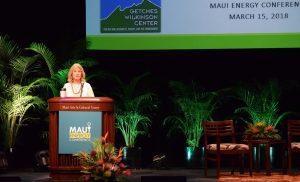
Alice Madden spoke on Day 2 of the 2018 Maui Energy Conference.
Day 2 began with a presentation by Alice Madden, Executive Director of Getches-Wilkinson Center for Natural Resources and former Principal Deputy Assistant Secretary of the U.S. Department of Energy.
“What I worried about most at the U.S. Department of Energy was the budget,” said keynote speaker Madden. “The federal government serves a significant role by helping to jumpstart new technologies necessary for efficiently and cost-effectively generating storing and using energy.”
Madden explained that most current battery storage technology started with U.S. Department of Energy funding assistance. That backing helped many small startups get past the initial “valley of death” period that new ventures must survive to succeed.
DECARBONIZING TRANSPORTATION
A panel on Decarbonizing Transportation updated recent developments in maritime, aviation, and ground transportation, especially e-bikes—a potential game-changer. The panel was moderated by Brennon Morioka, General Manager of Electrification of Transportation, Hawaiian Electric company; David Graham, Deputy Chief Operation Officer, Neighborhood Services, City of San Diego; Michael Hansen, President, Hawaii Shippers Council; and David Snyder, Executive Director, California Bicycle Coalition.
“San Diego offers a service called FRED: Free Ride Everywhere Downtown. This ride-sharing provides electric vehicles funded by parking meter revenues. Not only is it helping to have a clean method of moving people and making more parking available, it’s also creating a familiarity with EVs,” said Graham.
Morioka added, “We do need to put a larger focus on what is the largest contributor to carbon emissions, and that is the transportation sector.”
Last December, Hawaii’s four mayors came together to sign proclamations committing to an all-renewable transportation system by 2045. In January, Honolulu began testing its first electric bus during a six-week pilot project for its fleet. Maui was fortunate to be selected as the site of the JUMPSmartMaui demonstration project in 2011. The project tested new technologies and strategies to improve the integration of renewable energy resources into Maui’s electrical grid. Now EV drivers have access to 44 chargers across 13 Fast Charger stations on Maui.
Lee Chamberlain, rideSMART, Lahaina, an exhibitor at the conference said, “E-bikes are popping up all over the mainland. On Maui there are numerous bike lanes and a proposed 25-mile West Maui Greenway that will transform the abandoned cane haul road into a pedestrian-bicycle friendly community. With an e-bike you can easily maneuver through the Maui traffic in a safe, green and, most importantly, fun way.”
CASE STUDY: BALANCING EVS AND THE HIGHWAY FUND
A case study on Balancing EVs and the Highway Fund was presented by Ulupono Initiative Managing Partner Murray Clay.
“Electric vehicles do not pay any gas tax, and as EVs increase, highway funding will go down,” said Clay, who then asked, “How will the state fund its highway improvements as electric vehicles grow in number?”
Clay explained, “The gas tax is the largest source of funding for state highways at 31 percent. “But electric vehicles don’t pay a gas tax, so as more hit the streets, gas taxes will decline. So, we do have a potential problem in the future.”
Clay said the state Department of Transportation (DOT) is doing a study on replacing the gas tax with a Vehicle Miles Traveled (VMT) tax, which would charge all vehicles the same rate per mile.
“The problem is that would discourage energy-efficient vehicles. VMT, also known as Road User Fee, charges per mile driven,” said Clay. “Drivers pay for how much road they use rather than how much fuel they burn. Most transportation planning experts and the academic literature have VMT taxes as the correct answer. What’s wrong with the VMT tax is that the same VMT tax is on all roads and for all vehicle types.”
“The DOT deserves credit for being proactive,” Clay continued. “But energy and the environment are no less important; they must be considered. Swapping the gas tax for an across-the-board VMT tax is simply bad policy. It would overlook the state’s energy goals, primarily driven by the State Energy Office, as well as the state’s sustainability goals. Hawaii can do better by working together and across departments’ functional areas, while helping move the state toward its renewable energy and clean transportation goals.
A productive solution would be to gradually move from the gas tax to a VMT tax as EV share increases. Under this policy, everyone pays something for using the roads, yet there is still an incentive to be more fuel efficient and create less emissions. Energy consumption and consideration of environmental impacts are key.”
REVERSE-PITCH SESSION
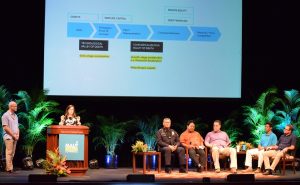
l to r: Fred Redell and Aki Marceau lead the Reverse Pitch Session with Tivoli Faaumu, David Rodriquez, Ben Sullivan, Ramsey Brown and Rocky Mould.
A reverse-pitch session was hosted by Aki Marceau, Director of Policy & Community Hawaii, Elemental Excelerator, and Fred Redell, Energy commissioner, Office of Economic Development, County of Maui. Organizations pitched their challenges to seek solutions, offered insight into the groundwork to remove barriers to achieving a decarbonized future in government and large companies.
Redell commented on Hawaii’s innovative history, “Innovation is key,” he said. ‘In 1891, the palace in Honolulu was using light bulbs by Thomas Edison. And now, they are using LED lights. Currently, Hawaii has new ideas to solve problems and we are making changes.”
Maui Police Chief, Tivoli Faaumu asked, “How can we improve efficiency in our response while maintaining officer safety in a low-carbon future? Our biggest cost is vehicles. We spend around $100,000 every year on fuel.”
David Rodriquez, Special Assistant, Hawaii State Department of Transportation – Highways, asked, “How can we improve Hawaii’s mobility through autonomous vehicle technology? We are pitching safety first but are looking at less parking possibilities as well as different lanes, driver behavior, and much more. It’s an ongoing study.”
Ben Sullivan, Energy Sustainability Coordinator, County of Kauai, asked, “What is a potential solution that will help catalyze movement away from conventional rentals? We are trying to figure out a low-carbon ground transportation. We have a 7-mile bike path and are looking at ways to get visitor innovation with carbon reduction.”
Ramsey Brown, Hawaii Energy Resource Acquisition Manager, asked, “How do we connect the everyday electric customer with the best-fit contractor to meet their specific energy needs? We are looking for ways to display products more efficiently for clean energy projects and connect customers with contractors for deeper energy conversations.”
Rocky Mould, Energy Program Manager, City & County of Honolulu, suggested solutions that include implementing the Paris Climate Agreement, improving city efficiency in buildings and fleets, and developing resilience strategy including climate-change action plan, and GIS maps.
Redell suggested to Police Chief Faaumu lowering the cost of transportation with EVs, more officers on foot, ride-sharing, and data-sharing.
INNOVATIVE COMMUNITIES CREATE A ROADMAP TO DECARBONIZATION
Frank De Rego, Jr. moderated a panel discussing how municipalities and states develop policies that address both renewable energy and climate. Panelists included Robert Mould, Energy Program Manager, City and County of Honolulu; Lucinda Smith, Environmental Services Department, Director, City of Fort Collins; and Ben Sullivan, Energy Coordinator, County of Kauai. Sullivan discussed Kauai’s current initiatives including performance contracting, electric vehicles, PV systems, the Kauai bus system, and other renewable energy projects.
“It is important for the islands to learn from each other by sharing our successes and challenges as we work toward greater renewable energy in Hawaii,” said Sullivan. “Kauai County’s current solar, smart grid, hydro, biomass, and wind projects, and their current challenges and opportunities, need to be studied in relationship to Maui and the rest of the state.”
“Kauai plans to triple its fleet of electric vehicles and wants to rely less on conventional rental cars in the future,” Sullivan said. “It’s a step in the right direction until the market opens up for things like garbage trucks and other vehicles as well.”
The Air Quality Program in Fort Collins, Colorado offers education, monitoring, reporting, and community action opportunities to help reduce specific air pollutants, as well as their collective carbon footprint.
“Our city has an established identity as a forward-thinking community that cares about the quality of life it offers its citizens,’ said Smith. “The Environmental Services Department, part of the Sustainability Services Area, supports our community’s values and adopted policy goals by offering programs and services that improve indoor and outdoor air quality; increase recycling and waste diversion; coordinate municipal sustainability activities; undertake environmental data management; and participate in municipal business partnerships and technical community efforts.”
Mould uses his experience in energy, economics, and financial analysis to help the city of Honolulu plan, organize, and implement its energy programs and priorities.
“Our city is committed to stay in the Paris Agreement and reduce greenhouse gas emissions through energy efficiency, grid modernization, and renewable energy use in electric generation and transportation,” Mould said. “In January, Honolulu tested its first electric bus during a six-week pilot project for its fleet.”
CARBON FARMING AND ENERGY CROPS
Addressing carbon sequestration in soil was moderator Rick Volner, General Manager of Diversified Agriculture for Alexander & Baldwin, and panelists Susan Crow, Assistant Professor, Department of Natural Resources & Environmental Management at the University of Hawaii Manoa; Caroline O’Brien, Founder and Chief Executive Officer, Carbon Drawdown Solution, and Fred Redell, Energy Commissioner, Office of Economic Development, County of Maui.

Susan Crow presented her ideas on Carbon Farming with other panel members Rick Volner, Fred Redell and Charlotte O’Brien.
“In the soil-vegetation-atmosphere system, most of the carbon is found in the soil. Finding ways to increase the carbon levels in the soil could offset a large amount of greenhouse gas emissions,” said Crow. “A unique opportunity exists for innovation to converge research and conceptualizations of soil health and payment for ecosystem services into an accessible, supportive planning tool and help define a future for adaptable, sustainable agricultural systems and integrated, productive landscapes in Hawaii.”
Crow added, “Trees planted in higher Hawaii elevations decreased sequestration, whereas in lower levels they increased sequestration. “The best plants were grasses with intense underground root systems.”
O’Brien, showed two side-by-side farms in Australia owned by two brothers. One field sequestered twice as much carbon as the other field. “The owner of the higher sequestered field practiced regenerative farming, whereby soil microbes were encouraged. Microbes worked with plants to build up carbon levels in the soil,’ she said. “The other brother used pesticides and fertilizers to kill off all pests including all microbes.”
Environmentalists are concerned that soil sequestration could justify continued air pollution, and that a poorly understood and poorly implemented system might totally fail to sequester carbon. Both speakers asserted that soil sequestration is an exciting field where a lot more research is needed.
IS HAWAII’S 100 PERCENT RENEWABLE PORTFOLIO STANDARD WORTH THE COST?
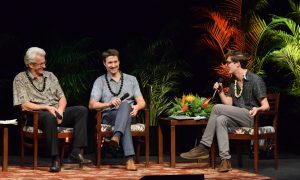
l to r: Rick Rochealeau, HNEI, and Jeff Mikulina, Blue Planet Foundation, discuss whether 100% RPS is worth the cost with Gavin Bade of Utility Dive.
The final panel of the conference featured Richard Rocheleau, Director of the Hawaii Natural Energy Institute (HNEI), Jeffrey Mikulina, Executive Director of the Blue Planet Foundation, and moderator Gavin Bade, Senior Reporter, Utility Dive, which provides a daily web-based newsletter on utilities and energy.
“The focus on decarbonization at this year’s conference helped illustrate the challenge of not just getting to 100 percent but ensuring that each sector of the economy is moving to a sustainable future,” said Bade.
Mikulina sparred a little on a few questions, and perhaps most importantly on the absence of a clear roadmap to get to 100 percent renewables.
Rocheleau worried about how Hawaii would get from 80 percent to 100 percent renewable electricity and stressed the need to make sure that the most efficient interim steps are taken, since the eyes of the world are on Hawaii. “We need to make sure we don’t take wrong steps along the way,” he said.
By contrast, Mikulina noted that the HCEI Energy Agreement signed in 2008 set ambitious goals that have been surpassed, while at the same time, several projects were not realized.
Over the years, HNEI has supported Big Wind, inter-island cable, and other interesting projects. Bill HB 1801, which would change how the renewable energy penetration level is calculated, and would require the gas company to undergo the same renewable energy transition required of electric utilities, is scheduled for an upcoming Senate hearing.
Summing up this year’s conference, James Griffin, Ph.D., Public Utilities Commissioner, State of Hawaii, said, “I absolutely believe we have the opportunity for a cleaner, more affordable energy system that serves the state better than the current system. I’m excited by the progress we can make in the next 10 years!”
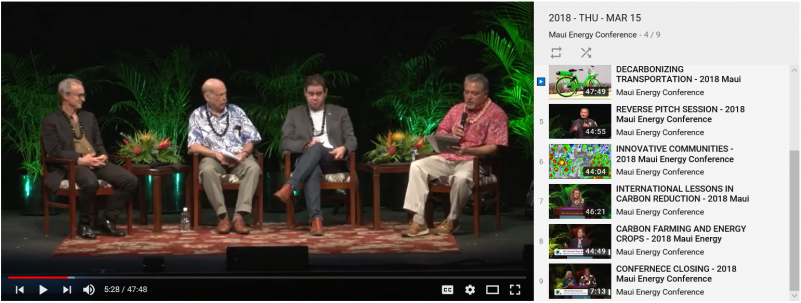

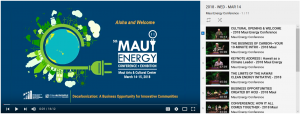

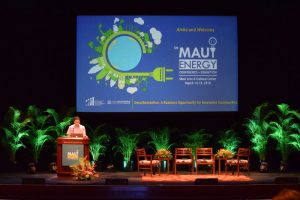
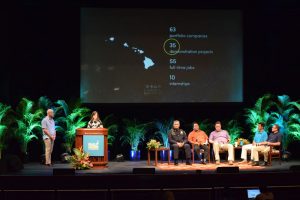








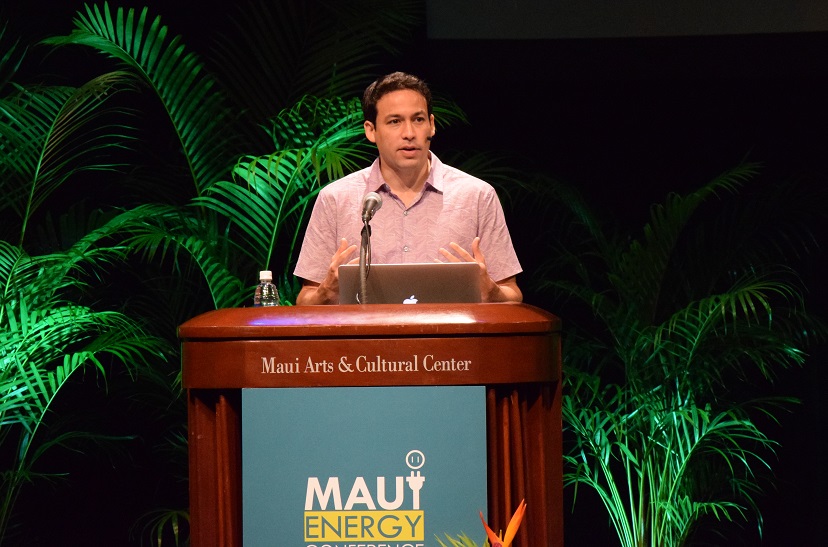
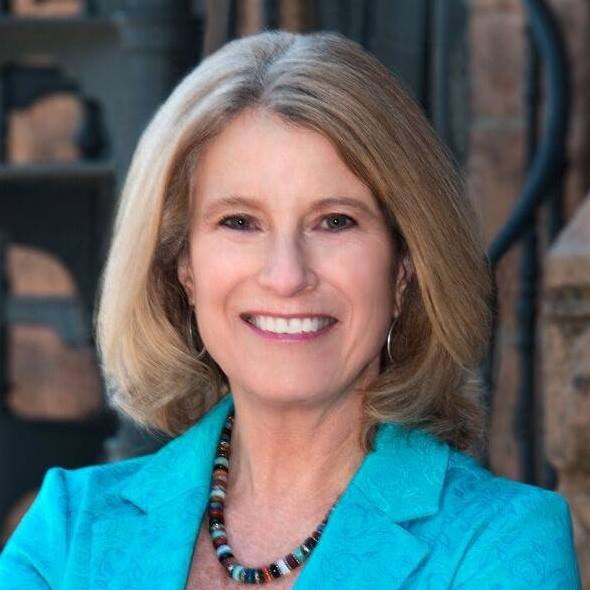

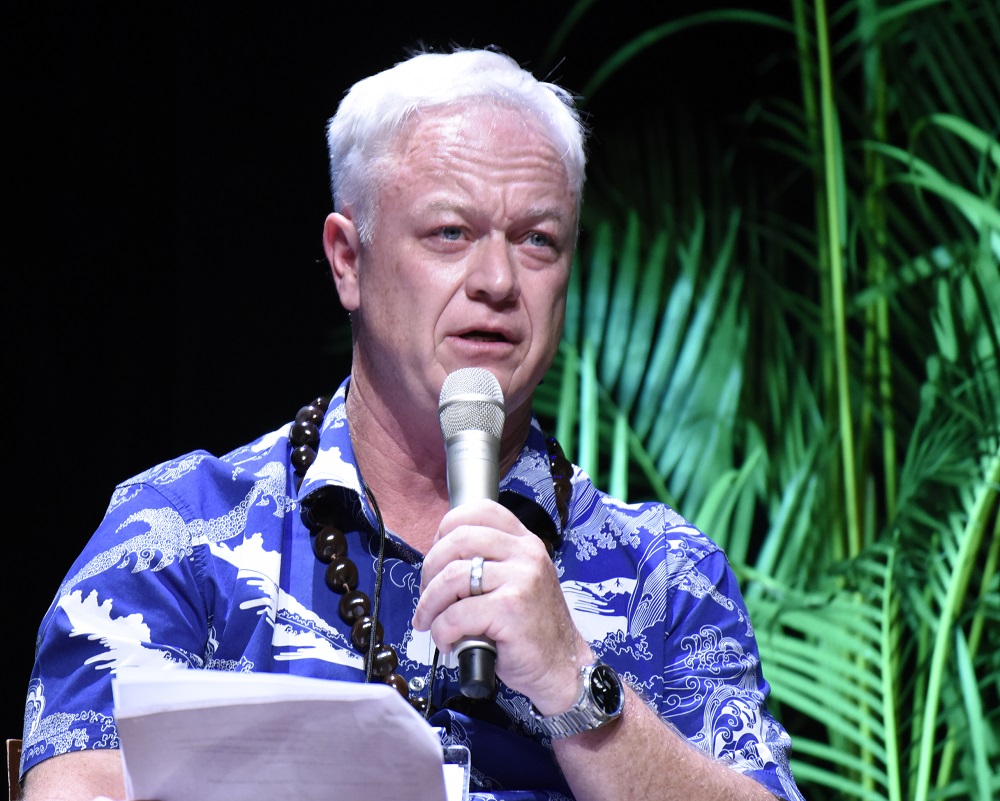
 This looks like a fundamental shift in how the Commission assesses the environmental impacts of producing energy in Hawaii. According to Conference Chair Doug McLeod: “The question is now whether the traditional ‘reasonable and prudent standard’ drives one to the conclusion that prudent people don’t want to make electricity in ways that might speed up climate change”. Sea change, game change, whatever type of change analogy you like – from a regulatory standpoint this is very different than where we were a few years ago.
This looks like a fundamental shift in how the Commission assesses the environmental impacts of producing energy in Hawaii. According to Conference Chair Doug McLeod: “The question is now whether the traditional ‘reasonable and prudent standard’ drives one to the conclusion that prudent people don’t want to make electricity in ways that might speed up climate change”. Sea change, game change, whatever type of change analogy you like – from a regulatory standpoint this is very different than where we were a few years ago.
